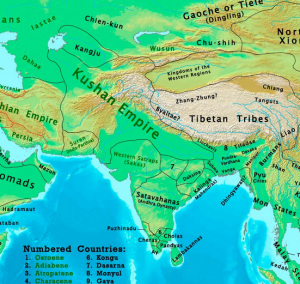Kushan Empire Origin
- Kushanas are considered to be one of the five branches of the Yuezhi tribe who lived in the Chinese frontier or central Asia.
- They are known as Guishuang in Chinese sources.
- They eventually acquired dominance over the other Yuezhi tribes.
- They moved eastward towards India defeating the Parthians and the Sakas in the 1st century AD.
Kushan Empire – Ruler Kujula Kadphises or Kadphises I
- Kujula Kadphises was the first Yuezhi chief to lay the foundation of the Kushana Empire in India.
- He established his supremacy over Kabul, Kandahar and Afghanistan.
- He was succeeded by his son Vima Taktu or Sadashkana (AD 80 -AD 95) who expanded the empire into northwest India.
Kushan Empire – Ruler Vima Kadphises [AD 95-AD 127]
- An inscription found at Rabatak in Afghanistan mentions that he was the son of Vima Taktu and the father of Kanishka.
- He has issued a large number of gold coins.
- He was a Shiva devotee as is clear from coins issued by him.
- A large number of Roman gold coins found from this era indicate the prosperity of India at that time and also the growing trade with the Romans.
Kanishka of Kushan Dynasty [127 AD – 150 AD]
- Considered the greatest Kushana king and also a great king of ancient India.
- Son of Vima Kadphises.
- His kingdom included Afghanistan, parts of Sindhu, parts of Parthia, Punjab, Kashmir, parts of Magadha (including Pataliputra), Malwa, Benaras, perhaps parts of Bengal, Khotan, Kashgar, Yarkhand (last three in modern China). His empire covered Gandhara, Peshawar, Oudh, Pataliputra, Kashmir and Mathura. His kingdom also included parts of Uzbekistan and Tajikistan.
- His main capital was Peshawar, then known as Purushpura.
- After the capture of Pataliputra, he is said to have taken away the Buddhist monk Ashvaghosha with him to Peshawar.
- The scholars in his court included Parsva, Ashvaghosha, Vasumitra, Nagarjuna, Charaka and Mathara. He also patronised the Greek engineer Agesilaus.
- Kanishka convened the fourth Buddhist Council at Kundalvana in Kashmir.
- He patronised Buddhism although he was very tolerant in his religious views. His coins contain a mix of Indian, Greek and Zoroastrian deities.
- He was also a patron of art and architecture. The Gandhara School of art flourished under him.
- He also propagated the Mahayana form of Buddhism and he was largely responsible for propagating it in China.
- It is not known how he died.

Achievements of Kushanas – Significance of the Kushana Empire
- Sanskrit literature began to be developed during this time. The fourth Buddhist council was held in Sanskrit.
- Ashvoghosha is considered to be the first Sanskrit dramatist.
- During this time, three distinct schools of art flourished: Gandhara School in northwest India, Amaravati School in Andhra and the Mathura School in the Ganges valley.
- Trade prospered between India and China, and India and the Roman Empire.
- The Kushanas controlled large parts of the Silk Route which led to the propagation of Buddhism into China. It was during this time that Buddhism began to spread to Korea and Japan also.
- Many towers, Chaityas, towns and beautiful sculptures were built under the patronage of the Kushana kings.
- Kushanas were foreign invaders, to begin with, but they were completely Indianised in ways and culture.
- It is said that the Kushana period in Indian history was a perfect forerunner to the golden age of the Guptas.
The decline of the Kushana Empire
- Kanishka was succeeded by his son Vasishka.
- Vasishka was followed by Huvishka and Kanishka II (son of Vasishka).
- Kanishka II was followed by Vasudeva I.
- Vasudeva I was the last great king of the Kushanas. After his death, the empire disintegrated away. He probably died in 232 AD.
